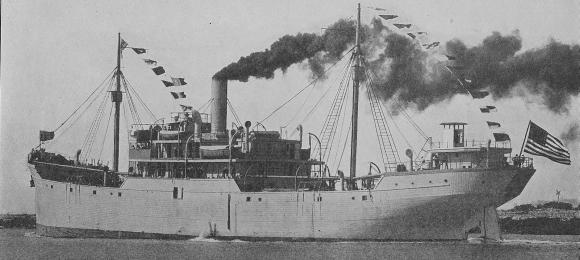
Ferris steamship
A world war was raging and German U-boats were sinking merchant ships faster than they could be built, so the United States government decided to build an emergency fleet of standardized ships. The goal was to build the ships quickly and cheaply to counter the submarine threat.
If the year was 1941, this might be the story of the Liberty ships. Instead, the year was 1917 during the First World War and the US Emergency Fleet Corporation (EFC) set out to contract for the construction of 703 wooden cargo steamships to supplement its slowly growing fleet of steel cargo ships. Several similar designs were ultimately built but the standard design was Theodore Ferris’ type 1001 design. They were 3 islander ships, 82.2 meters long (270′) 13.7 meters wide (45′). They had triple-expansion steam engines and were capable of cruising at 10 knots.
The ships were controversial from the start. Ships built of wood were considered obsolete and, even in 1917, many thought the triple expansion steam engine was outdated. Nevertheless, steel was in short supply, whereas timber was readily available, particularly in the Northwest, and reciprocating steam engines could be sourced quickly.
The project was not a success. When the armistice ending World War I was signed, 332 ships had been completed. Many contracts were canceled and partially built ships were sold for scrap. The ships earned a reputation for high maintenance and chronic rudder problems. Nevertheless, 265 of them carried some freight overseas. A post-war slump in freight rates soon sent the ships back into layup and to be scrapped.
We recently posted about the ghost ships in the Mallows Bay-Potomac River National Marine Sanctuary. many of the wrecks in the sanctuary are from the EFC wooden steamship fleet and many of these are Ferris ships. They were moved to Mallows Bay prior to being taken to a local scrap yard where the plan was to burn them and then gather the steel fastenings, rods and spikes which held the ships together. Before all of the ships could be scrapped, a collapse in scrap prices following the war left many ships to rot in ship graveyard of Mallows Bay.
While the Ferris fleet of wooden steamships was not successful, the standardized shipbuilding programs developed in World War I did provide a model for the highly successful construction of 2,710 Liberty ships between 1941 and 1945.

Thanks for the information. the pics in the previous post were excellent.
We still have our own Liberty Ship remains at the mouth of the river Medway in the Thames estuary. The Robert Montgomery is monitored regularly because much of her cargo of munitions is still in her holds and it is not considered safe to remove them.
Thank you for this history. I am really enjoying learning about the Ghost Fleet of Mallows Bay.
I find it interesting that the Mallows Bay ghost fleet gets widespread recognition, yet several other sites of abandoned WWI surplus Ferris and related-type ships never get mentioned.
At Everett, Washington, half a dozen of the probably most intact surplus ships form a breakwater at the mouth of the Snohomish River.
Near Gig Harbor, Washington, at least a dozen were burned, with their remains still visible in the sand at the mouth of Minter Creek.
At Orange, Texas, at least another dozen were burned, still visible in the Sabine River on the backside of Pavell Island.
At Baltimore, Maryland, another dozen are still visible where they were sunk as a breakwater at the mouth of Curtis Bay.
The provenance is a little less clear in other cases, but similar “ghost fleets” that may descend from the Emergency Fleet also exist at Portland and Astoria, Oregon, a couple of locations on San Francisco Bay, on the James and Elizabeth Rivers in Virginia, Tottenville, NY and at Portland, Maine among, I would imagine, many other locations.